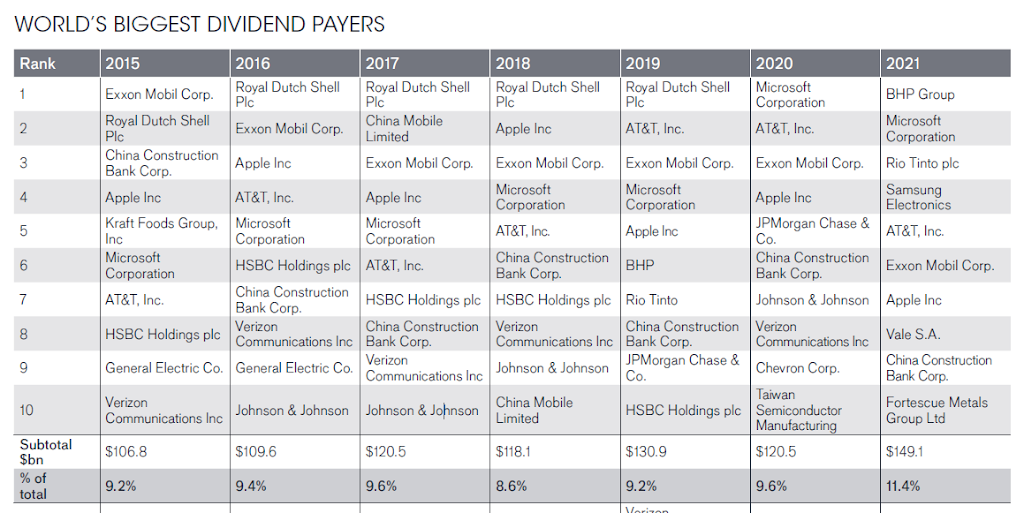I review the list of dividend increases each week as part of my monitoring process. This exercise pushes me to review existing holdings, and also to identify companies for further research.
I usually focus on the companies that have managed to increase dividends for at least a decade in those weekly reviews.
Over the past week
Ashland Global Holdings Inc. (ASH) provides additives and specialty ingredients worldwide. It operates through Life Sciences; Personal Care & Household; Specialty Additives; and Intermediates and Solvents segments.
The company increased quarterly dividends by 11.70% to $0.335/share. This marked the 13th consecutive annual dividend increase for this dividend achiever. Over the past decade, the company has managed to boost dividends at an annualized rate of 13.50%.
The stock sells for 21.24 times forward earnings and yields 1.23%
Canadian Imperial Bank of Commerce (CM) provides various financial products and services to personal, business, public sector, and institutional clients in Canada, the United States, and internationally.
The company increased its quarterly dividend by 3.10% to CAD $0.83/share. This payment is 13.69% higher than the distribution paid in July 2021. This marks the 12th year of consecutive annual dividend increases for this international dividend achiever.
The stock sells for 9.26 times forward earnings and yields 4.77%.
CTO Realty Growth, Inc. (CTO) is a Florida-based publicly traded real estate company, which owns income properties comprised of approximately 2.4 million square feet in diversified markets in the United States and an approximately 23.5% interest in Alpine Income Property Trust, Inc.
The REIT increased quarterly dividends by 3.70% to $1.12/share. The dividend represents a 12.0% year-over-year increase as compared to the company’s second quarter 2021 cash dividend. This is the tenth consecutive year of annual dividend increases for this dividend achiever.
The REIT sells for 14.06 times forward FFO and yields 6.16%.
Flowers Foods, Inc. (FLO) produces and markets packaged bakery products in the United States.
The company increased its quarterly dividends by 4.80% to $0.22/share. This was the 20th year of consecutive annual dividend increases for this dividend achiever. Over the past decade, the company managed to boost dividends at an annualized rate of 7.90%.
The stock sells for 21.92 times forward earnings and yields 3.22%
Insperity, Inc. (NSP) provides human resources (HR) and business solutions to improve business performance for small and medium-sized businesses.
The company lifted its quarterly dividends by 15.60% to $0.52/share. This was the 12th consecutive annual dividend increases for this dividend achiever. Over the past decade, the company managed to boost dividends at an annualized rate of 19.30%.
The stock sells for 21.11 times forward earnings and yields 2.08%.
Lowe's Companies, Inc.(LOW) operates as a home improvement retailer in the United States and internationally.
The company increased its quarterly dividends by 31.30% to $1.05/share. This marked the 60th year of annual dividend increases for this dividend king. Over the past decade, the company managed to boost dividends at an annualized rate of 18.80%.
The stock sells for 14.74 times forward earnings and yields 2.10%.
LyondellBasell Industries N.V. (LYB) operates as a chemical company in the United States, Germany, Mexico, Italy, Poland, France, Japan, China, the Netherlands, and internationally. The company operates in six segments: Olefins and Polyolefins Americas; Olefins and Polyolefins Europe, Asia, International; Intermediates and Derivatives; Advanced Polymer Solutions; Refining; and Technology.
The company increased its quarterly dividend by 5.30% to $1.19/share. In addition, it also declared a special dividend of $5.20/share. Over the past 5 years, the company managed to boost dividends at an annualized rate of 5.90%. This dividend achiever has managed to boost distributions for 11 years in a row.
The stock sells for 7.15 times forward earnings and yields 4.07%.
Medtronic plc (MDT) develops, manufactures, distributes, and sells device-based medical therapies to hospitals, physicians, clinicians, and patients worldwide. It operates through four segments: Cardiovascular Portfolio, Neuroscience Portfolio, Medical Surgical Portfolio, and Diabetes Operating Unit.
The company increased quarterly dividends by 7.90% to $0.68/share. This marked the 45th consecutive year of an increase in the dividend payment for this dividend aristocrat. Over the past decade, the company managed to boost dividends at an annualized rate of 10%.
The stock sells for 17.78 times forward earnings and yields 2.75%.
Royal Bank of Canada (RY) operates as a diversified financial service company worldwide.
The company increased its quarterly dividend by 6.70% to CAD $1.28/share. This payment is 18.51% higher than the distribution from this time in 2021. This marks the 12th consecutive year of annual dividend increases for this international dividend achiever.
The stock is selling for 11.60 times forward earnings and yields 3.52%.
TowneBank (TOWN) provides retail and commercial banking services for individuals, commercial enterprises, and professionals. The company operates through three segments: Banking, Realty, and Insurance.
The company raised quarterly dividends by 15% to $0.23/share. This was the eleventh year of annual dividend increases for this dividend achiever. Over the past decade, the company managed to boost dividends at an annualized rate of 9.40%.
The stock is selling for 11.42 times forward earnings and yields 3.11%
Unum Group (UNM) provides financial protection benefit solutions.
The company raised quarterly dividends by 10% to $0.33/share. This was the 14th year of annual dividend increases for this dividend achiever. Over the past decade, the company managed to boost dividends at an annualized rate of 11.50%.
The stock is selling for 7.07 times forward times earnings and yields 3.28%.
Relevant Articles:
- Ten Dividend Growth Stocks Rewarding Shareholders With a Raise






